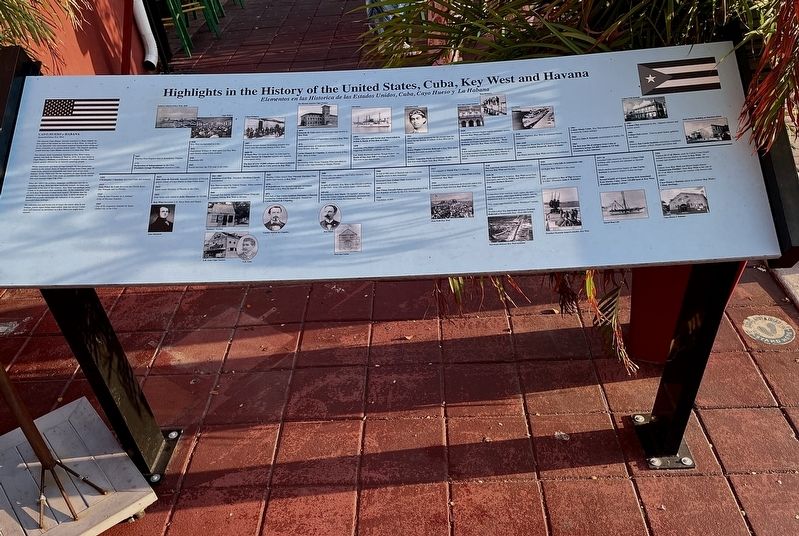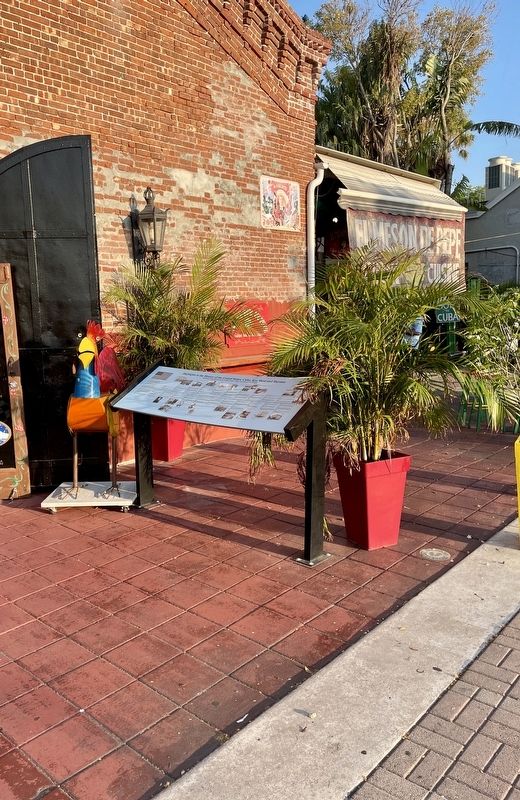Key West in Monroe County, Florida — The American South (South Atlantic)
Highlights in the History of the United States, Cuba, Key West and Havana
Elementos en las Historica de las Estados Unidos, Cuba, Cayo Hueso y La Habana
Inscription.
Cayo Hueso y Habana
Spanish/Cuban Key West
The Spanish Cayo Hueso literally translates to Bone Island, the first name of the island we now know as Key West. It was given by the Spaniards who discovered scattered human bones along our shore, remnants of an ancient Indian battle. The English speaking people hearing Cayo Hueso mistook it to mean Key West.
This historic brick warehouse, fronting on Key West's busy harbor, was built by William H. Wall in 1879.It is now home to Cayo Hueso y Habana, a celebration of a unique, remote island culture greatly affected by its Spanish speaking people.
While shipwrecks and their salvage brought the first permanent settlers to the island, those of Spanish heritage from Cuba, only 90 miles away, played an immediate and major part of our early history. In the 1860s and 70s the migration of cigar factory owners and their workers from Cuba made an indelible mark on the island that soon became Cigar City USA.
Since the 1860's the politics, language, architecture and the atmosphere of Key West has been markedly mixed. At times and especially at the turn of the century, Key West was perhaps more Cuban in its persuasion than anything else. In the centennial year of 1876 Key West had a Cuban born mayor. To ensure that the memory of our Spanish roots does not fade, Cayo Hueso y Habana proudly showcases the influence of the people of Spanish/Cuban heritage.
We welcome you and invite you to enjoy the music shop in our bodega, watch cigars being hand-rolled, taste our savory Cuban food and discover an adventure in a Key West you might have missed.
Christopher Columbus discovers Cuba and America
1513
Juan Ponce de León discovers the Florida Keys, Dry Tortugas and La Florida.
1515
"Villa de San Cristobal de la Habana" (City of Havana) founded.
1565
City of St. Augustine founded by Spain.
Pilgrims from England land at Jamestown, Virginia.
1776
Declaration of Independence by the USA. (President George Washington elected in 1789)
Don Juan de Estradá, Spanish Governor of Florida grants island of Cayo Hueso to Juan Pablo Salas.
1819
Spain cedes Territory of Florida to the USA.
1822
Juan Salas sells island to John Simonton for $2,000.
Key West becomes U.S. Navy Base and Depot.
Key West incorporated as a city.
1831
Englishman William H. Wall opens first Key West cigar factory using Cuban workers.
1840
Population 688
1845
Florida becomes the 27th state in the USA.
American Civil War. President Abraham Lincoln assassinated.
Key West occupied by Federal Troops. Many southern sympathizers stay on island.
1866
Telegraph line laid by International Ocean Telegraph Company linking Key West to Havana.
German émigré Samuel Seidenberg pioneers first major clear Havana leaf factory in Key West.
1868-78
10 Years War "El Grito de Yara" in Cuba lead by Carlos Manuel de Céspedes (against new spanish conscription laws)
The first of over 15,000 refugees and insurrectionists fleeing Spanish rule in Cuba arrive in Key West.
1870
El Republicano first Spanish language newspaper published in Key West by Juan M. Reyes.
1871
First hall of San Carlos Institute Patriotico y Docente founded by Cuban exiles is dedicated. Named for Carlos Manuel de Céspedes.
Edwardo H. Gato opens second major cigar factory in Key West
Cooperative Union of Cigarmakes formed at Key West.
1876
100th anniversary of American Independence from Great Britain, July 4th.
Carlos Manuel de Céspedes, Jr. elected mayor of Key West. Born in Cuba.
1885
Devastating strike forces Vincente Ybor and others to relocate some cigar business to Tampa, Florida.
Catastrophic fire destroys San Carlos Institute, Ybor's factory and ten others.
1890
In spite of setbacks, Key West is the Cigar Capital of the USA. Over 100 million cigars rolled annually.
1891/92
Revolutionary José Marti, "El Apóstol" arrives here, unites the Cuban emigres and formally proclaims the manifesto of the Cuban Revolutionary Party.
Cuban Liberator and Pariot José Marti killed in action in Battle of Dos Rios in Cuba.
1898
Battleship USS Maine explodes in Havana Harbor triggering Spanish - American War.
Col. Teddy Roosevelt and his "Rough Riders" win Battle of San Juan Hill at Santiago de Cuba. War over in just four months.
At end of 400 years of Spanish rule in Cuba manyémigrés return to their homeland.
Sociedad Cuban(Cuban Club) founded by new immigrants from Cuba.
1902
Don Tomas Estradá Palma appointed President of the new Republic of Cuba by the U.S. Government.
1910
Population 19,945
100 million cigars produced for the second time but forces for the decline of industry in Key West are in motion.
1912
Henry Flagler's Oversea Railroad to Key West opens, bringing thousands en route to Cuba.
1913
Aviators Augustine Parlá and Domingo Rosillo make first over-water flights from Key West to Cuba.
USA engaged inWorld War I in Europe.
Sociedad Cuban incorporated. Cuban Club building constructed, Key West.
1919
Compaña Cubana-Americana de Aviacion makes first commercial flight between Key West and Cuba.
Aeromarine Airways begins regular passenger service between Key West and Havana.
Prohibition (of the manufacture, sale and use of alcoholic beverages) promotes smuggling. "Rum Running between Key West and Havana thrives.
1924
A new and magnificentSan Carlos Institute, designed by Cuban architect Francisco Centurion y Maceo is built by Cuban government on Key West's Duval Street.
Pan American Airways begins scheduled service between
Key West and Havana.
1929-36
Great Depression in America. Key West saved from bankruptcy and ruin byFERA and WPA assistance. (President Herbert Hoover)
1930
Population 12,831
Competition from machine made cigars, the new cigarette market, other cigar making centers, and the Depression lead to a rapid decline in employment.
Only small cigar factories called "Buckeyes" remain.
1935
Terrible Labor Day hurricane destroys Oversea Railroad at Matacumbe Key. Over 400 killed.
Overseas Highway, Key West to mainland Florida completed.
1941-1945
US engaged in World War II in Europe and the Pacific. (Presidents Franklin Roosevelt, Harry Truman)
1954
Car Ferry between Key West and Havana established.
Democratic Cuba falls to communist rule.
All flights Key West to Cuba cease.
1961
U.S. participates in Bay of Pigs invasion in Cuba. (President John F. Kennedy )
1963
President John F. Kennedy assassinated in Dallas, TX.
1965
The first boat lift of refugees from Cuba at Camarioca brings 165,000 Cubans to US Soil. (President Lydon Johnson)
Sociedad Cuba dissolved. Historic Cuban Club building sold, restored and operated as Spanish Restaurant.
Much needed restoration begins on San Carlos Institute to preserve island's Cuban heritage.
1980
Second boatlift of Cubans fleeing their homeland from Mariel, Cuba. Over 125,000 land at Key West. (President Jimmy Carter)
Cuban Club destroyed by fire. Original columns and turrets saved.
1989
Cuban Club rebuilt. Used as guest house, galleries and shops.
1992
Historic San Carlos Institute restoration completed. Used as museum, school, theater and music hall.
Tugboat.El 13 de Marzo, sunk by Cuban Coast Guard outside Havana Harbor en route to Key West. 35 women and children drown and remain under the sea.
1995
Cubans from Key West and Miami begin annual "Democracia Flotillas" from Key West to the site of El 13 de Marzo to honor the victims with flowers and prayers.
1997 Cayo Hueso y Habana opens to celebrate Key West's Cuban Heritage…
(captions)
Business District of Key West, 1838
Cigar Rollers
John Simonton
"Buckeye" Factors
E.H. Gato Cigar Factory
E.H. Gato
Cuban Refugees
Carlos Manuel de Céspedes
The Havana America Cigar Factory
José Marti
First San Carlos
USS Maine
Augustine Parla
First Train Key West
New San Carlos Institute
Rum Runners
Hurricanes destroys Key West extension
Car Ferry
President Kennedy inspects missiles, Key West
Cuban Club Rebuilt
Mariel Boat Lift
Gato Factory Building on Simonton Street
Cayo Hueso Y Habana
Topics. This historical marker is listed in these topic lists: Hispanic Americans • Industry & Commerce • Settlements & Settlers. A significant historical year for this entry is 1492.
Location. 24° 33.602′ N, 81° 48.433′ W. Marker is in Key West, Florida, in Monroe County. Marker can be reached from the intersection of Wall Street and Exchange Street, on the left when traveling north. The marker is located at the west entrance to Cayo Hueso y Habana Restaurant. Touch for map. Marker is at or near this postal address: 410 Wall Street, Key West FL 33040, United States of America. Touch for directions.
Other nearby markers. At least 8 other markers are within walking distance of this marker. Cuban Missile Crisis (within shouting distance of this marker); The Mosquito Fleet (within shouting distance of this marker); Civil War Union Blockade (within shouting distance of this marker); Waterfront Playhouse (within shouting distance of this marker); Dr. Jeptha Vining Harris (within shouting distance of this marker); Norberg Thompson (within shouting distance of this marker); Cayo Hueso (within shouting distance of this marker); Charley P. Toppino (within shouting distance of this marker). Touch for a list and map of all markers in Key West.
Regarding Highlights in the History of the United States, Cuba, Key West and Havana. The subtitle of the marker is in error. "Las Historica" isn't grammatically correct and should probably be "la Historia".
Also see . . .
1. Cayo Hueso y Habana Historem. (Submitted on September 1, 2023, by Brandon D Cross of Flagler Beach, Florida.)
2. William Wall Warehouse. (Submitted on September 1, 2023, by Brandon D Cross of Flagler Beach, Florida.)
Credits. This page was last revised on September 2, 2023. It was originally submitted on September 1, 2023, by Brandon D Cross of Flagler Beach, Florida. This page has been viewed 72 times since then and 25 times this year. Photos: 1, 2. submitted on September 1, 2023, by Brandon D Cross of Flagler Beach, Florida. • Bernard Fisher was the editor who published this page.

